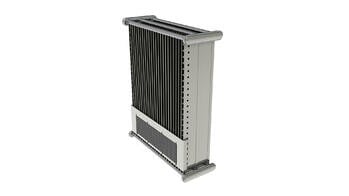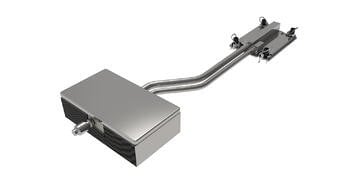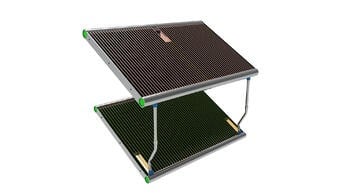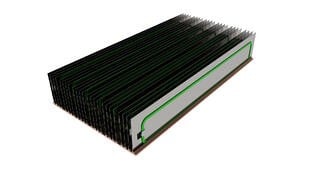Nel nostro blog precedente, abbiamo esaminato le basi dei termosifoni e come funzionano. Mentre sono tutti sistemi passivi bifase che contengono tre parti di base (un evaporatore, un circuito di fluidi e un condensatore), il modo in cui sono costruiti può essere diverso a seconda di come vengono utilizzati.
In questo blog, esamineremo i tipi di configurazioni del termosifone e alcune applicazioni comuni per ciascuna.
Quali sono le diverse configurazioni del termosifone?
Al Boyd, i termosifoni sono generalmente suddivisi in quattro categorie principali:
Termosifone ad anello di contatto diretto 3D:
- Industrie e applicazioni tipiche: Industriale e telecomunicazioni (inverter di potenza, azionamenti motore, torri 5G, unità radio remote, radio MIMO)
I termosifoni ad anello a contatto diretto 3D dissipano il calore da una o più fonti di calore montate direttamente alla base del termosifone. Questi termosifoni sono dotati di tubi di alimentazione del vapore e di ritorno del liquido nella base e nelle alette, nonché collettori che diffondono il calore attraverso l'intero volume 3D delle alette collegate.

Il fluido di lavoro assorbe il calore e si trasforma in vapore mentre scorre attraverso i tubi nella base più vicina alla fonte di calore e sale verso l'alto dalla galleggiabilità. I collettori che rivestono la parte superiore e inferiore del gruppo consentono al vapore e al fluido condensato di distribuirsi a ciascuna aletta garantendo una struttura isotermica 3D per un raffreddamento costante. L'aria naturale o forzata scorre attraverso il gruppo di alette quasi isotermiche per respingere il calore nell'ambiente circostante con alta efficienza. Quando il calore viene respinto dal sistema, il fluido di lavoro si ricondensa nei tubi delle alette, dove ritorna per gravità al collettore liquido nella parte inferiore e ritorna all'evaporatore per ripetere il processo.
Termosifone ad anello a contatto diretto:
- Industrie e applicazioni tipiche: Industriale ed Enterprise (CPU, GPU, Inverter, Server)
Uno dei tipi più comuni di termosifoni, i gruppi termosifone ad anello a contatto diretto presentano componenti separati del condensatore e dell'evaporatore, che sono distanziati e collegati da tubi accuratamente orientati. La base dell'evaporatore è montata direttamente su una fonte di calore come una CPU o una GPU. Il calore del dispositivo vaporizza il liquido stagnante all'interno dell'evaporatore, facendolo viaggiare attraverso il tubo di vapore fino all'unità condensatrice remota.

Il condensatore è dotato di una pila di alette ad alta densità, in cui il flusso d'aria forzato ambientale rimuove il calore dal sistema. Quando il calore viene rimosso, il fluido di lavoro si ricondensa, rifluendo attraverso un tubo di ritorno nell'evaporatore.
Termosifone ad anello aria-aria:
- Industrie e applicazioni tipiche: Telecomunicazioni, eMobility e industriale (armadi, edge computing, torri 5G)
I termosifoni aria-aria funzionano in modo simile ad altri tipi di scambiatori di calore aria-aria, ma utilizzano la tecnologia Thermosiphon loop invece di tubi di conduzione o calore per trasferire calore da un flusso d'aria all'altro. Un evaporatore e uno scambiatore di calore a condensatore sono collegati da tubi con metà del sistema situato all'interno di un involucro e l'altra metà all'esterno dell'involucro.

L'aria calda interna dall'involucro fa evaporare il fluido sulla batteria dell'evaporatore, che sale attraverso il tubo di vapore nella bobina del condensatore. L'aria esterna forzata scorre attraverso la batteria del condensatore, ricondensando il fluido di lavoro che poi scorre attraverso i tubi di ritorno per gravità fino alla batteria dell'evaporatore dove il processo si ripete.
Pinna termosifone 2D:
- Industrie e applicazioni tipiche: Industriale e Telecom (5G, Radio remota, Radio MIMO, Inverter, sostituzione o miglioramento dei tradizionali dissipatori di calore ad alette estrusi, colati o incollati)
Forse la più unica delle categorie Thermosiphon, le alette Thermosiphon 2D sono alette individuali migliorate con la tecnologia Thermosiphon. Utilizzati principalmente come alette standard per aumentare la superficie effettiva delle alette per la dissipazione del calore, i termosifoni sono incorporati in ciascuna aletta per aumentare l'efficienza delle alette e le prestazioni complessive.

Questi termosifoni incorporati, disponibili in un loop, a nido d'ape o a microcanali, migliorano significativamente le prestazioni delle alette standard in alluminio. Le alette a termosifone 2D riducono il peso e possono ridurre i volumi del dissipatore di calore ottimizzando le prestazioni termiche e sono comunemente utilizzate grazie al modo in cui possono essere miscelate e abbinate ad altre tecnologie termiche tradizionali.
Mentre queste sono le categorie generali per i termosifoni in Boyd, ognuna può essere personalizzata per adattarsi a un'ampia varietà di applicazioni. Se hai domande sui nostri termosifoni o su quale sia l'ideale per il tuo prossimo progetto, visita il nostro sito web o contatta i nostri esperti.






